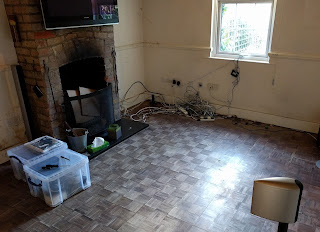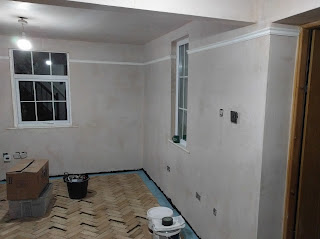We've been planning to decorate the living room for many years but the idea of moving all the furniture out and the upheaval kept putting us off.
This year we planned it and started work just after Christmas.
We were a couple of days later than intended because neither of us were feeling very well.
Keith came round for several days to help. Stripping the old flooring, channelling out for some conduits, repairing the floor.
I added a chemical damp proof course along two walls as there was clearly a problem under the stairs. I also wanted an extra damp proof layer over the whole floor and slightly up the walls. We used that to hold the thermal insulation sheets down.
There were two especially big jobs. The acoustic boards on the party wall and the floor.
We started with the acoustic sheets on the walls. Each half sheet of part plasterboard and part foam weighed 28Kg! We held those on to the wall with some strong multi fix adhesive and some hammer fixings. With three of us, that job was easier than expected.
The walls and ceilings were then plastered for us and the end result is very nice.
Keith cut out a bit of the screed from under the stairs to find the source of the damp. That exposed what we assume was the original floor surface. That got a damp proof layer and filled back in.
The other big job which we did while the plaster was drying, was the floor. We bought the reclaimed parquet flooring over 10 years ago. We originally used it in the extension with plans to do the living room as well. There was a lot of work cleaning up each block and then even more work lining it up and gluing it down. Followed by cutting and fitting the diamond shapes parallel with the walls. That in turn followed by fitting two rows round the edges of the room and some fiddly finishing bits.
Because it was reclaimed it had bitumen on the back. Sikabond 5500S is one of the few adhesive I could find that said it could be used on bitumen. It's expensive. Unknown, until we opened the tin, it has a strong solvent smell. It also eat in to the insulation board but luckily, once dry, it was stable. The insulation board had the advantage of being able to take up the different in the thicknesses of the bitumen residue.
Due to the delayed start we did things in a slightly different order than originally planned.
Shelley painted the walls and ceiling while I was at work. The walls are Farrow and Ball off-black No.57 estate emulsion paint. Shelley said it is the best paint she has ever used.
It already looked good at this stage but having spent a few minutes trying to sand the floor we decided it was worth paying a professional.
We are so pleased we did. Michael, from Essex Woodfloor Sanders, spent a full day just sanding with some very heavy equipment. His small sander was so heavy it could barely be lifted by one person. The large sander had to be taken apart to get it in the house.
Apparently the floor was very hard to sand and took longer than expected. This and the colour has led him to think it might be maple rather than oak. I had expressed my doubts about it being oak before he started. It was too pink and some blocks were a bit harder to cut than I expected, so I am happy to accept the conclusion that it is probably maple.
He filled all the gaps, sanded a lot and then, on the second day, added several layers of water based sealant using a roller for the most part.
The end result is just an amazing floor. When, one day, we can clear out the hall and study, we will get him back to finish those floors.
We are currently waiting a few days before putting anything heavy on the floor. That works out OK for me because I am back at work, so will not have time until the weekend.
==





























No comments :
Post a Comment